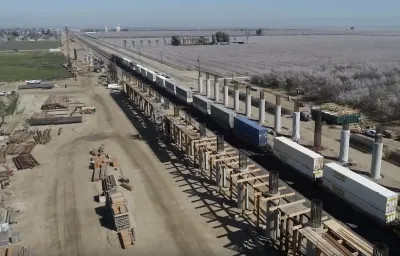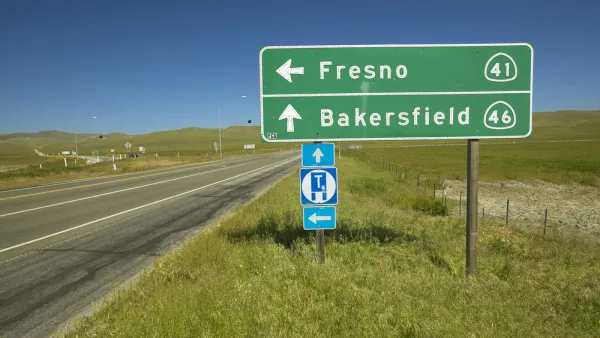A newly restructured leadership promises to speed up the arduous construction process and start running trains in five to eight years.

After a restructuring of the authority’s leadership, the California High-Speed Rail Authority (CHSRA) says it plans to begin running trains in five to eight years, reports Skip Descant in GovTech.
As Descant explains, “The 494-mile project to connect San Francisco and Los Angeles with trains traveling up to 220 mph has been hobbled by complications ranging from land acquisition to utility relocation to funding to political opposition, since voters approved a bond measure that paid for it in 2008.”
There are currently 171 miles of rail line under construction between Merced and Bakersfield in the Central Valley. According to the CHSRA, “Up to 24 stations will be constructed and the project will soon begin the phase of laying track and erecting the overhead catenary system of wires supplying electricity.”
The project will eventually connect to Palmdale, a desert community north of Los Angeles and a hub for the regional Metrolink train, in the south and to Gilroy, a town south of San Francisco with a Caltrain station, in the north.
FULL STORY: Restructured Calif. High-Speed Rail Is Poised to Lay Track

National Parks Layoffs Will Cause Communities to Lose Billions
Thousands of essential park workers were laid off this week, just before the busy spring break season.

Retro-silient?: America’s First “Eco-burb,” The Woodlands Turns 50
A master-planned community north of Houston offers lessons on green infrastructure and resilient design, but falls short of its founder’s lofty affordability and walkability goals.

Delivering for America Plan Will Downgrade Mail Service in at Least 49.5 Percent of Zip Codes
Republican and Democrat lawmakers criticize the plan for its disproportionate negative impact on rural communities.

Test News Post 1
This is a summary

Test News Headline 46
Test for the image on the front page.

Balancing Bombs and Butterflies: How the National Guard Protects a Rare Species
The National Guard at Fort Indiantown Gap uses GIS technology and land management strategies to balance military training with conservation efforts, ensuring the survival of the rare eastern regal fritillary butterfly.
Urban Design for Planners 1: Software Tools
This six-course series explores essential urban design concepts using open source software and equips planners with the tools they need to participate fully in the urban design process.
Planning for Universal Design
Learn the tools for implementing Universal Design in planning regulations.
EMC Planning Group, Inc.
Planetizen
Planetizen
Mpact (formerly Rail~Volution)
Great Falls Development Authority, Inc.
HUDs Office of Policy Development and Research
NYU Wagner Graduate School of Public Service





























